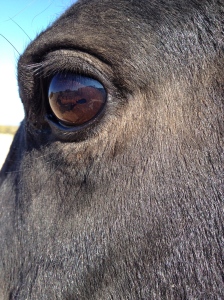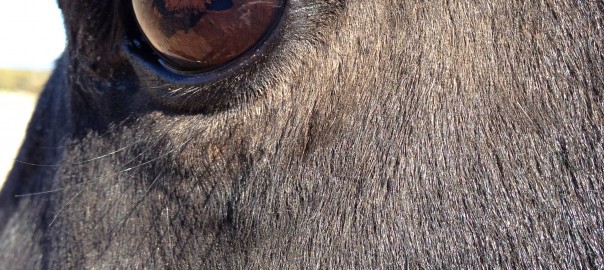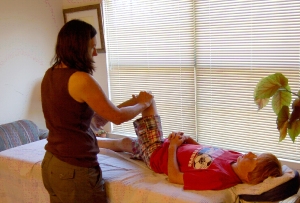A lot of times owners ask me if their horse or dog is in pain. Generally they don’t ask about their family members because people can verbalize their pain. When I work on humans I rely heavily on what they tell me as far as pain goes, and how it’s going – is it getting better, worse, is there any change whatsoever?
What I have to go on with animals is much more subtle. It may seem subtle at first but once you start watching for the signs, you can check it out yourself. Horses can exhibit pain symptoms around the mouth, eyes and nose, and more obviously in the legs, neck, spine, shoulders and hindquarters. They may kick, bite, move away, groan and yank their leg away if they are in pain. When we check for back pain, we can palpate down the spine to see if the horse flinches to our touch. Some horses don’t show pain when you do this because they are very stoic.
Dogs may growl, bite, snap, lunge, squeak or move away. Pain is also evident in their eyes and face, if you can read stress or tension there. Sometimes a limb may be stiffly clenched against the body. Some are also very stoic and try not to show pain.
I look for heat, irregularity in the joints and tissues, swelling, how the eyes are tracking, how they carry themselves. With humans, the same attention to detail can be used, adding to what they tell me about their condition.
The other day I worked on an old dog whose feet were very hot. She was having trouble getting her hind legs to cooperate, and when I palpated her legs I found that the femur joint lacked bone and cartilage. Because of her age, pain moves around in her body but had settled in the hind legs at this visit. Treatments help relieve her discomfort for a week or so and she can continue taking short walks with her owners.
A mare who has really good feet and was in good physical condition suddenly lost energy, her heels dropped to the ground and her toes became elongated. This was not initiated by hoof care but hoof care was required to help the situation. With some herbal supplementation and EPR, her body bounced back and the system righted itself. We may never know what caused this. She may have been on her way to getting laminitis, but the situation was derailed before it became really serious.
A man came to me recently with terrible shoulder pain. In Ortho-Bionomy we work with eight shoulder points, and invariably there will be pain in one or many of those points. In this case one point in particular was triggered, and damage to the neck was contributing to the shoulder pain too, but two sessions has helped lessen the pain and make sleeping much more comfortable for him.
A horse of mine began to be wobbly on the trail, and the vet suggested I give him bute after finding he didn’t test for any known neurological disease. I didn’t want to mask the problem with bute because it surely seemed neurological. Instead I worked on his immune and lymph systems from various aspects to get him strengthened. It took a few months but he got better, without drugs or any invasive procedures. I recalled that a couple of months before these symptoms showed up he had gotten a bad whack on the head which had required stitches and it had left him dizzy and dazed. Although the cut he got from that was sewn up, there remained some concussion symptoms as a result.
![[Catherine Sobredo Photography]](https://horsesatliberty.files.wordpress.com/2012/08/imgp2225-edit.jpg?w=300)
Ortho-Bionomy and Equine Positional Release are so effective for treating the entire organism by way of working with the entire central nervous system. Even when a being is in a lot of pain, these methods are gentle enough to use and at the same time, are very powerful and effective. The addition of other remedies such as herbs and homeopathics can also assist the “healing from within” process.
Private sessions and gift certificates are available by calling 505.501.2478 or emailing susansmith@orthohorse.info
Beginning in March, regular EPR Study Groups will be held in Santa Fe, NM. Look at www.orthohorse.info or www.eprortho.com for calendar announcements for classes.
(copyright) Susan Smith, OrthoHorse





I have a left shoulder that was “frozen” for a year about 20 years ago. It rarely gives me problems but recently became very painful. I was seeing Susan for a session on my back and happened to mention the shoulder pain. She worked on it and in just the one session it was totally gone. Although my chronic, decades-old back problems require regular sessions, I can’t say enough about how much the Ortho helps, and, because I caught the shoulder pain immediately, it didn’t stand a chance in Susan’s capable hands!
Thank you, Leta, I’d forgotten your once-frozen shoulder since we’ve been working on other things. It seems it is a common occurrence in everyday life but really can be easily remedied im many cases. I never stop being surprised at how effective a treatment can be, for myself and others!
Thanks for this insightful article on spotting pain in horses. I continue to learn from your blog!
Thanks, Ruella. It’s always good to hear from you 🙂